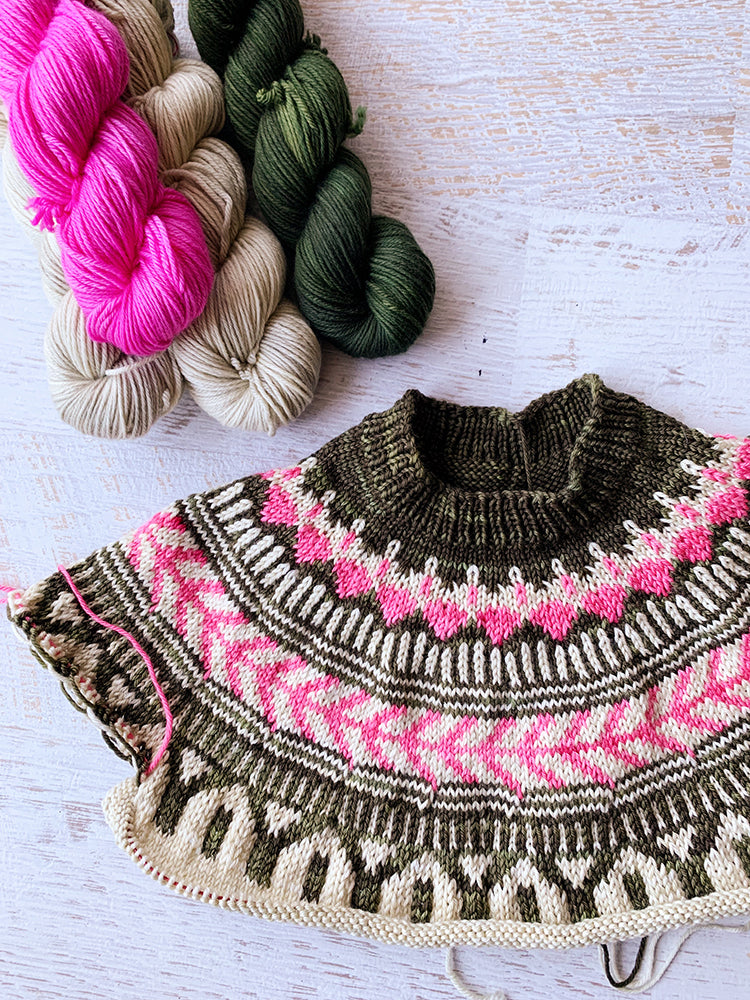ジャーナル

Pattern Spotlight - Soldotna Crop With A Twist.
This week our pattern spotlight is the Soldotna Crop by Caitlin Hunter. I have been knitting one for myself using our Cushy DK/8ply and, since it's our yarn of the week, I thought it would be perfect for our spotlight pattern.

The Soldotna Crop was designed to use four colours; however, I have seen three colour versions and was inspired to try them myself. I'm using Olive, Parchment and Orchid and I am super happy with how it's knitting up! This does mean that the small colourwork 'spots' in the body will be omitted, but I'm totally fine with that.
If you are interested in creating your own three-colour Soldotna Crop, here are my tips.
I suggest choosing a palette that consists of a dark, a medium (or a bright) and a light colour. This will give you the best contrast and will really make the colourwork pop. Next, you need to work out your colour placement. The pattern is written for four colours (C1, C2, C3, C4), and this is my suggestion for how to order your colours for a three-colour version.
Light-Coloured Soldotna Crop (body will be light)
- C1 - will be your darkest colour
- C2 - will be your lightest colour
- C3 - will be your medium or bright colour
- C4 - you will use colour 2
Dark-Coloured Soldotna Crop (body will be dark)
- C1 - will be your lightest colour
- C2 - will be your darkest colour
- C3 - will be your medium or bright colour
- C4 - you will use colour 2
I am knitting a light version, so my C1 is Olive, C2 and C4 is Parchment, and C3 is Orchid.
If you are after some new stash to cast on a three-colour Soldotna, I have put together a few colour palettes using this week's colourways. They have been photographed in order with the first 2 skeins on the left being light, then dark and the medium/bright at the end. You can create your own light or dark Soldotna using any of these combinations (I have listed the yardage you will need below).







- Silver (light), Char (Dark) and Just Peachy (mid/bright).
- Botticelli (light), Midnight Blue (dark) and Just Peachy (mid/bright).
- Parchment (light), Olive (dark), Orchid (mid/bright).
- Tequila (light), Marigold (dark), Thistle (mid/bright).
- Silver (light), Char (dark), Orchid (mid/bright).
- Silver (light), Char (dark), Marigold (mid/bright).
- Tequila (light), Sushi (dark), Persimmon (mid/bright).
For a three-colour version your yardage will of course change; here is what you will need.
Sizes 1(2,3,4,5,6){7,8,9,10}
Finished circumference at bust:
32.75 (36.5, 40, 44.5, 48, 52.5) {56, 59.75, 64, 67.75} ”
83 (92.5, 101.5, 113, 122, 133.5) {142, 152, 162.5, 172} cm
This sweater is designed to fit with 1-4.5” 2.5-11.5 cm of positive ease at the bust.
C1: 1 (1, 2, 2, 2, 2) {2, 2, 2, 2} skeins Cushy/DK weight yarn.
C2: 2 (2, 2, 2, 2, 2) {2, 3, 3, 3} skeins Cushy/DK weight yarn.
C3: 1 (1, 1, 1, 1, 1) {1, 1, 1, 1} skeins Cushy/DK weight yarn.
If you have any questions, just use our contact page and I'll get back to you.
Have a great weekend xx
ファイバーフォーカス - モヘア
モヘアの人気は、モヘア シルク レースを別の糸と一緒に使用したり、単独で使用したりする新しいパターンの急増により、最近非常に高まっています. Ravelryには現在、モヘア混紡糸を使用した31,000近くのデザインがあり、代表的なパターンには、広瀬みどりのラナンキュラスやプティ ニットのノー フリル セーターなどがあります。では、モヘアについて何を知っていますか?正直なところ、あまり詳しくは知りませんでしたが、少し調べたところ、非常に興味深い繊維であることがわかりました。それでは、詳しく見てみましょう。

まず、モヘア繊維はアンゴラ山羊から作られます。アンゴラ繊維が生産されるアンゴラウサギも存在するため、これはしばしば混乱を招く可能性があります.アンゴラ山羊とウサギは、原産地がトルコの首都アンカラである「アンゴラ」であるため、同じ名前を共有しています。
モヘア繊維には、ウールに見られるものよりも薄く、滑らかで、大きい微細なスケールが含まれています。これらのうろこは、モヘアに美しい輝きを与え、繊維がフェルト化するのを防ぎ、汚れや水に対する耐性を提供します (両方とも滑らかな表面から簡単に滑り落ちるため)。また、モヘアは難燃性があり、ウールよりも暖かいです。ただし、ウールよりもはるかに耐久性が低く、60 °C (140 ° F) を超える熱湯で洗うと、光沢が失われ、もろく黄色くなります。これは、染色する場合や紡績用のフリースを準備する場合に知っておくことが重要です。

モヘア繊維は細かいものから粗いものに分類され、最も細かいものは「スーパーファイン キッド」、最も粗いものは「アダルト」です。大人のモヘア繊維は非常に粗く、主に室内装飾品やカーペットに使用されます。手編みやかぎ針編み用に紡がれた糸は、スーパーファインまたはキッドのいずれかを使用し、通常、メリノやシルクなどの別の繊維とブレンドされます.これは、モヘア繊維が伸縮性に優れているためですが、ウールとは異なり、傷がついていない状態には戻りません。つまり、メモリがありません。極細のモヘアは、ヤギ (または子供) が生後 6 か月の最初の毛刈りから生まれます。カシミヤのような柔らかな肌触りです。キッドモヘアは2回目以降の剪断でできたもので、スーパーファインほど柔らかくありません。したがって、非常に柔らかいモヘア (カシミヤのように柔らかい) を探している場合は、ラベルを読み、「スーパーファイン」に分類されていることを確認してください。
モヘアのキッティングは、特に別の糸で二重に保持する場合に喜ばれます。モヘアを異なる色の糸と一緒に編んだときに発生する色の効果は、魔法のようです。私は現在、Tin Can Knits のLove Note Sweater を編んでいます (上記参照)。生地の感触と 2 つの色が一緒に編まれる方法の両方が気に入っています (私は Top Draw Sock ベースでそれを保持しています)。 .しかし、私はいくつかのステッチを引き裂く必要があり、モヘアへの愛は少し弱まったかもしれません.モヘアは、引き裂くときに厄介なことで有名です。長い繊維が絡まり絡まり、ほどけにくい!私ができる唯一のアドバイスは、非常にゆっくりと行うことです。また、プロジェクトを冷凍庫に入れると元に戻すのが簡単になると聞いたことがあります。これとは別に、モヘア糸は編むのが楽しく、出来上がったアイテムは暖かく、柔らかく、着心地が良い.モヘア糸で編み物をしたことがない場合は、ぜひ試してみることをお勧めします.
あなたはモヘアのファンですか?それについて何が好きですか、それとも嫌いですか?この繊維からブレンドされた糸で編むには、どのようなパターンをお勧めしますか?以下のコメントに投稿してください。
xx

